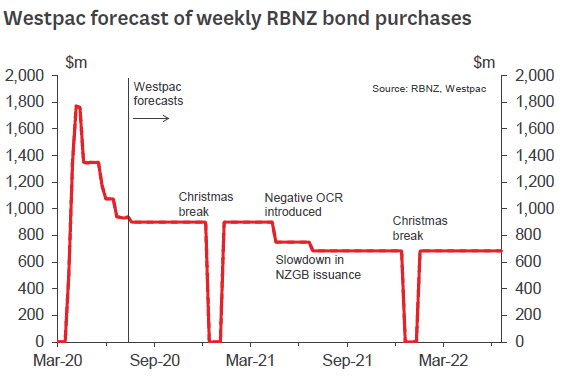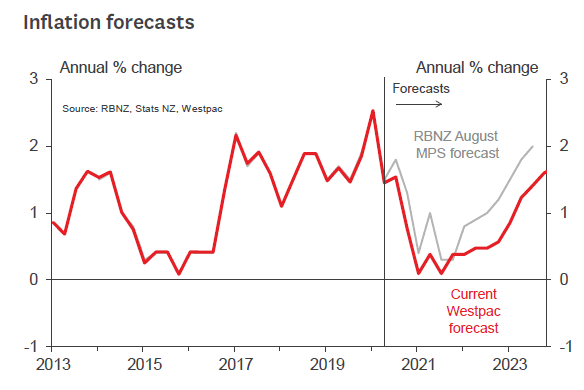- Like us, the RBNZ does not think that the medium-term outlook for the economy has changed much.
- The RBNZ extended its Large Scale Asset Purchase (LSAP) programme from $60bn to $100bn.
- But this is not necessarily a further monetary easing, because the larger quantum of purchases will be spread over a much longer timeframe.
- $100bn is as far as the RBNZ can go with the LSAP.
- If even more monetary stimulus is required, the RBNZ implied that it would opt for a negative OCR combined with loans to banks.
- We have long been the only bank forecasting a negative OCR, but the idea will probably now gain wider acceptance.
- As we said in May, we expect the LSAP will eventually total $100bn and the OCR will drop to -0.5% in April 2021.
The Reserve Bank today provided useful clarity to markets. It clarified that it intends to purchase bonds under the Large Scale Asset Purchase (LSAP) programme for much longer than the May 2021 date it had previously been explicit about. And the RBNZ clarified that if the economy requires more monetary stimulus than the LSAP alone can deliver, then its next tool would be a combination of a negative OCR and direct loans to banks.
None of this surprised us. The RBNZ’s announced policy now looks much closer to our long-held forecasts for monetary policy. Back in May we said that the LSAP would have to be extended in time, and in order to purchase bonds over such a long timeframe, the cap on the LSAP would have to be increased to $100bn. We have also long predicted that the OCR will fall to -0.5% in April 2021. The RBNZ did not go that far today, but they inched a little closer in that direction by saying that a negative OCR is a preferred policy option.
Consequently, there was nothing in today’s announcement that will materially change our monetary policy forecasts.
Being explicit about the LSAP.
The RBNZ expanded the cap on the Large Scale Asset Purchase (LSAP) programme from $60bn to $100bn, and sold the move as a further monetary easing. We would regard this as “further” only in the sense that the RBNZ has extended the timeframe of the LSAP. Previously the LSAP programme was $60bn by May 2021, which implied an average weekly purchase pace of around $900m per week. Now the LSAP is $100bn by June 2022, which implies an average purchase pace of only $800m per week.
The RBNZ’s new, extended LSAP description is slightly more generous than the forecast we issued in our MPS preview last week (see chart below). There might be some scope for us to lift our forecast of the pace of bond purchases in the near term, but it is marginal. We have long expected that the RBNZ will purchase bonds a little more rapidly this year, and will taper the pace of purchases next. The RBNZ confirmed that is its plan in today’s MPS.
Like us, financial markets already expected the RBNZ would extend the LSAP well beyond May 2021, so the market reaction to today’s RBNZ announcement was limited.
According to our calculations, $100bn by June 2022 is the upper limit for the LSAP. The recent better-than-expected economic data is going to mean smaller government deficits, and therefore less government bond issuance, than previously thought. We now forecast that the Government will issue around $50bn of bonds this year, and $35bn next (previously $60bn and $40bn). If the RBNZ buys $100bn, then by June 2022 it will own 59% of all government bonds, and there will be about $70bn in private hands. Buying any more than that would imperil market liquidity.
(Much was made of the indemnity the Government provided the RBNZ, covering the purchase of up to 50% of all bonds on issue. But this indemnity was never a binding constraint, as it can be altered at the stroke of a pen. Indeed, today the indemnity was increased to 60%.)
Should New Zealand’s economic situation worsen – and yesterday’s announcement of a move up the Covid-19 Alert Level system could be a catalyst for such a worsening – then the Government would probably borrow and spend more. That would increase the size of the NZ Government Bond market, giving the RBNZ scope to further increase the LSAP. However, in this case the RBNZ would probably also require another monetary policy tool.
Even if the economic outlook doesn’t worsen, we still think New Zealand is going to require more monetary stimulus than the LSAP alone is capable of providing. The RBNZ’s forecasts have inflation dropping to 0.3% next year, and returning to 2% only by late 2023. That is borderline-acceptable for a central bank that has long been battling lowflation. But we actually think inflation will linger at low levels for even longer than the RBNZ expects. Therefore, we think more monetary stimulus is required.
Negative OCR – out of the wilderness.
Recognising the possible need for further monetary policy firepower, today the RBNZ clarified its thinking on the next step beyond the LSAP. The RBNZ said its preference remains for a negative OCR. This would work in much the same way as a regular OCR cut, by reducing short-term wholesale rates, flowing through to lower lending and deposit rates for customers, and putting downward pressure on the exchange rate.
The RBNZ noted that “a lower OCR would likely increase the effectiveness of LSAPs by lowering short-term interest rates and allowing LSAPs to flatten the yield curve at a lower level.” This is a change of heart from the RBNZ’s earlier work on alternative tools, where they suggested that having already used large-scale bond purchases would make a negative OCR less effective.
The new development in today’s review was that the RBNZ now seems to favour combining a negative OCR with a term funding facility for banks (essentially direct loans). This would help to ensure that lower wholesale interest rates are passed through to lending and deposit rates.
The other alternative tool highlighted in the MPS was purchasing foreign assets instead of New Zealand Government bonds. However, the RBNZ doesn’t appear to be convinced that this is the right tool for the current conditions, and it also carries a significantly higher level of risk for the public sector balance sheet, so this option seems less likely.
Westpac has long been alone in forecasting that the OCR will drop to -0.5% in April 2021. Today’s announcement was a major shot in the arm for our forecast. Financial markets have been loath to incorporate much chance of a negative OCR into fixed interest rates, but that could change following today’s announcement. Indeed, forward pricing for the OCR in August 2021 has dropped from zero to -0.05%, indicating a decent chance that the OCR will be below zero at that point.
Like us, the RBNZ has not really changed its overall assessment of the economic and inflation outlook. The RBNZ’s “unconstrained OCR forecast,” which gives a sense of the overall degree of monetary stimulus that is required, has not changed relative to the May MPS, and is still sitting at -2% for two years. Like us, the RBNZ has acknowledged the surprising resilience of the economy to date. But like us, the RBNZ is concerned about the longer-term outlook due to health uncertainty, the likelihood that the borders will be closed for longer than previously thought, and the weak global economy. Consequently, the RBNZ has not really altered its longer-term GDP forecast (again, similar to us). The RBNZ is also concerned that medium-term inflation will be supressed by a recent increase in the exchange rate and possibly a fall in inflation expectations 

















